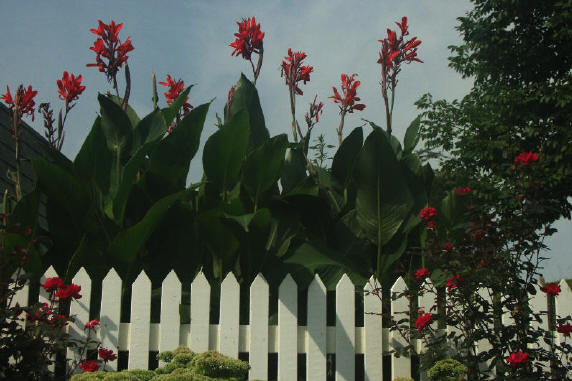|
Canna Lilies - Care & Winterization
Carolyn Black
Adams County Master Gardener
 Canna Lilies are a favorite in our garden. Canna is the only genus in the family of Cannaceae. In August and September, when other flowers have reached their peak, the Canna Lilies are displaying a magnificent showcase of color and texture in the flower bed. The main reason that we
plant Canna Lilies is because hummingbirds are attracted to them. So, what makes hummingbirds happy makes us happy! Canna Lilies are a favorite in our garden. Canna is the only genus in the family of Cannaceae. In August and September, when other flowers have reached their peak, the Canna Lilies are displaying a magnificent showcase of color and texture in the flower bed. The main reason that we
plant Canna Lilies is because hummingbirds are attracted to them. So, what makes hummingbirds happy makes us happy!
Canna Lilies are not true lilies. The name Canna originates from the Celtic word for a cane or reek.
Canna Lilies are lovely in the garden because of their bold accent. Their tropical appearance makes a spectacular show in any flower garden. They grow three to five feet high. They look beautiful displayed in a large container or urn. The colors of the flowers are usually vibrant shades of red, yellow, or orange. The broad, flat, alternative leaves
are typically green, purple, or variegated. They grow out of the stem in a long, narrow roll and then unfurl. Although gardeners enjoy these interesting flowers, nature really intended them to attract pollinators, such as bees, hummingbirds, and bats, so that they could collect the nectar and pollen. The pollination mechanism is conspicuously specialized. Pollen is shed
on the style while still in the bud, and in the early hybrids some is also found on the stigma because of the high position of the anther, which means that they are self-pollinating.

A single flower spike of a Canna Lily can last several weeks. The spent flowers should be deadheaded to preserve the plantís energy and also to keep the plant looking attractive. Canna Lilies bloom from about mid-summer until the first frost.
Cannas need moisture to keep blooming. They should be planted in well drained, rich, organic soil. Because of their tropical characteristics, they love the hot, humid weather. Canna Lilies prefer full sun, but can survive in partial shade.
Cannas are remarkably disease free. The leaves may become the victim of slugs and snails.
Cannas are winter hardy in zones 7 to 10. Therefore, in our area the rhizomes (roots that shoot) must be lifted and stored indoors for the winter. Cannas grow from a thick, multi eyed, rhizome type of root system. After the first frost, the leaves will turn black. The rhizomes will freeze and rot if left in the ground.
It takes a little extra work to winterize the Canna Lilies but it is worth the effort. Just after the first killing frost, dig a foot or so away from the stem of the Canna so that the rhizome is not damaged. When the soil is loosened around the crown, grab the stem and gently lift the clump out of the ground. Wash the roots off with a spray of
water. Cut off the tops of the Canna Lilies and add them to your compost pile. They grow and spread fairly fast so you will be pleasantly surprised by the surplus production of the rhizomes. The rhizomes can be stored in plastic grocery bags. Store the roots in a spot where the temperature stays between 45 to 60 degrees. An attic, basement, or crawl space is a possibility
for storage. If the area is too warm, mold will grow. If the location is too cold, they may freeze.
In early spring after the tulips have bloomed, the Canna Lilies can be planted outside. Vegetative reproduction can be done at this point by dividing the roots. Make sure that each divided piece has at least one node, where new leaves will grow next year.
They should be planted four to five inches deep and one to four feet apart. Once you get them in the ground, they will bloom in 10- 12 weeks. Canna Lilies are easy to grow and your surplus of Canna Lily rhizomes will be an appreciative and thoughtful gift to share with family and friends.
Read other articles on plants and gardens
Read other fall related gardening articles
Read other articles on birds, wildlife & beneficial insects
Read other articles by Carolyn Black
|